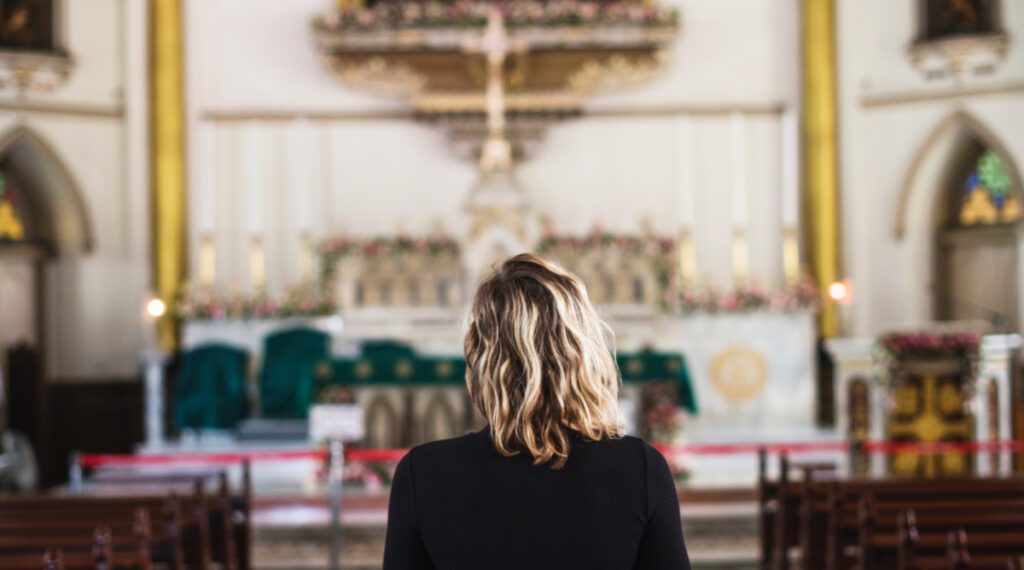Readers of this SpiritualDirection.com blog, students in the Avila Institute, members of the Avila Army and Apostoli Viae, and listeners to Divine Intimacy radio all will have some notion of the spiritual life and have heard the phrase ‘divine intimacy’. Others may have become acquainted with these through the sound preaching of their pastor, online podcasts and courses, or the writings of the saints. The Christian life is intended to be a close union with God, and our nature is designed for it. These tidbits of knowledge are like teasers, awakening an internal desire within that sends us seeking answers.
St. Ignatius of Loyola experienced this as well. As an injured soldier convalescing at his sister’s home in 16th century Spain, he read about the lives of the saints and asked himself how they came to live so heroically for God. Our loving Lord guided Ignatius as he overcame sin and grew in virtue, both of which are outcomes of growing intimacy with God. Ignatius chronicled his experiences for the purpose of directing others in the spiritual life, which became the Spiritual Exercises of St. Ignatius of Loyola. Considered a ‘school of prayer’, the Exercises form one into the holy habit of living a discerning life; that is, living a life in intimacy with God such that His love inspires one to do everything possible to return that love to Him and share it with others. The person conforms their life to His will not as an intellectual endeavor (like the Pharisees of ancient Judaism following their laws) or of scrupulous self-hatred but, rather, as a response to love. It is the natural outcome to experiencing the relational dynamic of love within the Trinity.
The spiritual life, our relationship with God, is eternal and never-ending. Similarly, the Spiritual Exercises have no ‘end’. The person taking the retreat is formed to continue such that their life after the retreat becomes one of prayer, of ongoing conversation with our Lord. It is the retreat that never ends.
Our faith teaches us that true happiness is found in God and that we are created to praise, revere, and serve Him. As we grow in knowledge of God, we grow to understand ourselves too. The retreatant learns not only to follow His Divine will in accord with His moral teachings, but also to discover His will for their life, their purpose, and His great hope for them. This purpose is always part of His larger plan of bringing all souls to salvation, and in the Exercises, the retreatant becomes excited to join in God’s project.
In 1540, when approving the book of the Exercises and Ignatius’ plans, Pope Paul III remarked “The finger of God is here.”[1] This ‘little’ book is deep and complicated when understood as intended. Divine intimacy can only develop through a firm understanding of God’s truth as given in scripture and tradition. In fact, Ignatius quoted many great saints in his letters and instructions. No saints were sanctified by living a ‘comfortable’ contemporary interpretation of God’s teachings, but many were sanctified refuting such. It was God’s intent through Ignatius to lead people on the path to holiness, and it remains His intent with the Spiritual Exercises today.
With all that said, you may still be wondering: what exactly are the Ignatian spiritual exercises?
The Ignatian exercises are a retreat rather than a program, course, or bible study. The person ‘taking’ the exercises is referred to as an exercitant. A word that is as difficult to pronounce as it is to spell, I prefer to refer to them as a retreatant.
The book begins with a series of twenty annotations, which are Ignatius’ advisements on directing the exercises. The remainder of the book contains the various meditations for prayer with detailed instructions, as well as over 60 rules such as discernment of spirits, thinking with the mind of the Church, scruples, and rules for eating. These were originally designed to be a 30-day silent retreat for men, referred to as the “20th annotation”. However, for those who cannot separate themselves from their daily responsibilities, the 19th annotation advises these can be led in their daily life by dedicating time daily to the meditations and meeting regularly with the spiritual director. This spans six to nine months. Both these forms of the retreat require the person be educated in their Catholic faith and of sound mind. In the 18thannotation (Mullen translation 1914), Ignatius also allows for the exercises “to be adapted to the dispositions of the persons who wish to receive them, that is, to their age, education or ability, in order not to give to one who is uneducated or of little intelligence things he cannot easily bear and profit by.”[2] Over the centuries thousands, perhaps millions, of people have experienced this 18th annotation form of the exercises in retreats lasting 3, 5 or 8 days. The modern 18thannotation uses the same structure of prayers as in the full exercises, simply scaling it down to several meditations. In the ‘full’ exercises (19th & 20th) the director’s role is to listen to the retreatant’s experiences in prayer, provide guidance including discernment of spirits, and then provide instructions for the upcoming meditations. In the 18th annotation form (commonly held in groups), the director usually gives ‘conferences’ or talks after which the retreatant prays an assigned meditation.
The exercises are first and foremost a school of prayer; specifically, discursive meditation moving us to contemplative prayer. It was never intended to be merely an aesthetical formation (kicking bad habits and developing self-control) or of spiritual warfare. Although these are features of the exercises, both are intended to support the person in developing a trusting friendship with their God.
Not anyone should complete the exercises in the 19th or 20th form. “[I]t is not a method of Christian perfection; but it contains the entire practice of perfection, by making us at once conquer sin, and acquire the highest virtue” (Right Reverand Nicholas Wiseman, Spiritual Exercises Rothaan version, p. 11[3]). These were designed for those already catechized in their Catholic faith, of sound mind and mental stability, and who are prepared to address the source of their sins in an orderly manner. For example, Pierre Favre (now Saint Pierre Favre, in English St. Peter Fabre) suffered so deeply with scruples and anxiety that Ignatius personally directed him spiritually for four years before permitting Favre to take the Exercises. Thereafter, the other men said Favre was the best spiritual director of them all (excluding Ignatius, of course).
An important feature of the Exercises is that we learn to follow God step by step so as to live in the grace of the present moment (also known as the sacrament of the present moment). The full materials are not given to the retreatant. In fact, prior to this century, the retreatant might not even know the Exercises were a book, as they had no need to possess it. The ‘book’ is written for spiritual directors, not retreatants, and so cannot be properly understood without that accompanying formation. In this century, however, it has become popular to give the retreatant the book and even self-guided exercises can be found on the Internet. At best, this information serves to distract the retreatant but, more concerning, it risks the retreatant maintaining some element of control in a retreat whose very purpose is to give up control so as to experience (and eventually live in) moment-to-moment metanoia (conversion).
The director’s key role is listening for growth, for surrender. Otherwise, the retreatant risks convincing themselves that their own psychological fantasies are experiences with God and their own way of thinking is God’s will. Thus, it is a time of self-honesty for the retreatant, and the director must already possess this quality as well. The risk of a passive disposition to God is that anything that comes to mind can be confused to be from God. Ignatius gives numerous instructions not only on discerning these spirits but also in thinking with the Church, thrashing all against the core truths of faith. As Rev. William A. M. Peters explains:
“For, intense susceptibility and receptivity, even passivity, open the door to an uncritical acceptance of whatever suggests itself of the soul as the true voice of God. This must be counterbalanced by a sober and strict adherence to the mind and doctrine of the Church; obviously, there can be no disagreement between the Spirit that governs and directs the exercitant and the same Spirit that guides and rules the Church” (The Spiritual Exercises of St. Ignatus Exposition and Interpretations, p. 4 cf. Sp. Ex. 365).
Thus, even in those meditations which involve use of our imagination, such as on hell, the angels, the last judgement, etc., Ignatius’ focus is on the mysteries of God, not ourselves, nor on achieving some sort of emptiness (such as in centering prayer). The purpose is for us to live out the mysteries, not to achieve what we think is consolation.
The purpose is for us to live out the mysteries, not to achieve what we think is consolation.
If the Director is using materials other than the original exercises, it is important these be faithful to scripture, tradition, and the teachings of the saints (as previously stated). In recent decades, numerous books have been published with the author’s preferred interpretation of the Exercises. These often present guidance and meditations from the perspective of secular ideologies, whereas the purpose of the Exercises is to remove the retreatant from worldly thinking in order to take on the mind and heart of Christ. The retreatant should not need to sift out fallacy in the materials in order to find truth. Sanctification is, after all, healing the woundedness in the soul and this can only be done with God’s grace. It is difficult to follow the Holy Spirit’s lead to grace if we follow a poorly written, secularized, or errant form of the Exercises.
It is difficult to follow the Holy Spirit’s lead to grace if we follow a poorly written, secularized, or errant form of the Exercises.
In the Christian tradition, spiritual growth—that is, growth in relationship with our Triune God—is commonly illustrated as moving through three stages: purgation, illumination, and union. Made to His image, we are to grow in His likeness throughout this mortal life on earth. The exercises are designed to do just that. Ignatius termed the four phases or movements in these exercises as ‘weeks’. However, these are not calendar weeks, so it becomes confusing. Rather, these parallel the stages of spiritual growth taught by saints and holy authors in the centuries preceding Ignatius (and later solidified in our spiritual theology as taught by Teresa of Avila and John of the Cross).
Week one, the purgative stage, is one of discovering God’s mercy and love for the retreatant even in their worst times of sin. With mortal sin conquered, the long battle against venial sin (known and unknown) continues through the remainder of the exercises. Weeks two and three meditations focus on the life and passion of Christ in a personal way from which blossoms a deep and mature love for our Lord (week 4). Most retreatants remain in the illuminative stage of relationship in this long period of transformation. However, Ignatius believed the Holy Spirit would lead people into union with God, which is marked by the habitual presence of Him in their soul.
The Holy Spirit uses the Director to guide the retreatant towards understanding their prayer experiences. Differentiating between God’s voice, their own, and that of the enemy is necessary to following His will. The Director’s own formation and experience of the spiritual life is necessary to understanding the retreatant’s experiences in the Exercises. Therefore, the Director must already be advanced into the Illuminative stage of relationship with God and have had formation to know the subtle nuances that symbolize true spiritual growth vs. flights of fancy. They must be able to recognize true virtue, particularly as demonstrated by the retreatant’s cautious prudence in understanding spiritual things while doing so in the love of our Lord and others, which signifies the action of the Holy Spirit. The importance of a well-formed Director is critical to the benefit of the retreatant just as a poorly formed Director can be harmful.
Ultimately, the exercises are intended to form us in living the greatest commandment: “you shall love the Lord, your God, with all your heart, with all your soul, and with all your mind and you shall love your neighbor as yourself” (Matthew 22:37, 39) and “As I have loved you, so you also should love one another” (John 13:34). Because of this, the exercises have no end. While the time in retreat comes to a conclusion, the retreatant is to continue living and praying in this manner the rest of their days. The Exercises form us to live the discerning life, one in which our love of God—a true love that is relationship with Him–is infused and embedded in our daily life activities, conforming our will to His. They are designed to make us saints.
Ad Majorem Dei Gloriam!
[1] William Young transl. (1956) Saint Ignatius’ Own Story. Loyola Press. P. vi
[2] Ignatius of Loyola (1914) The Spiritual Exercises of St. Ignatius of Loyola. Rev. Elder Mullen, transl. P.J. Kennedy & Sons.
[3] Ignatius of Loyola (1869) The Spiritual Exercises of St. Ignatius of Loyola., with extracts from the literal version and notes of the Rev. Father Rothaan S.J. Charles Seager, ed. First American edition. Webb, McGill & Co.
____________________________________________________
Image: Depositphotos




